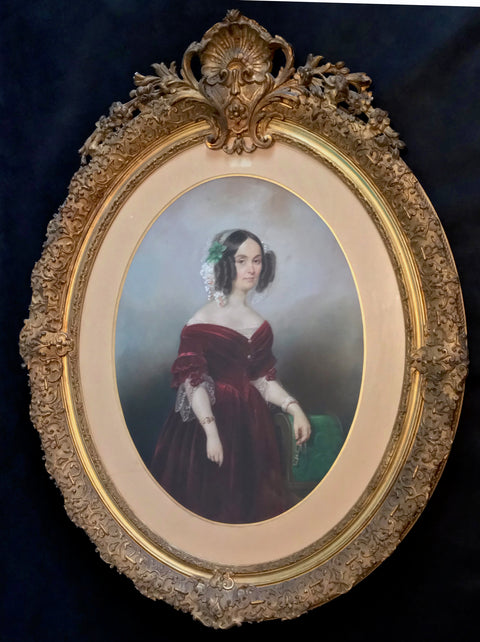

Angelique Mezzara, Portrait de Mme la comtesse de Salvandy
$6,399.00
Choose variants
Select Title
Out of stock
Price
$6,399.00
Angélique Mezzara
Portrait de Mme la comtesse de Salvandy 1847, pastel 62cm x 48cm
24,4094 inches x 18,8976 inches
Signed lower right : Angelique Mezzara
Frame102cm x 77cm
1847. Portrait de Mme la comtesse de Salvandy, pastel.[38]
Angélique Mezzara
From Wikipedia, the free encyclopedia
Angélique Mezzara, born Marie Angélique Foulon, (1793 – September 13, 1868) was a French portrait painter and miniaturist, who frequently worked in pastels. During a time when few women were painters, she exhibited regularly for nearly 30 years at the Paris Salon, the major art event of the time. Two of her sons became sculptors, and a daughter exhibited with her at the Paris exhibition as a painter.
Known works
The Dictionnaire général des artistes lists the following works shown at the Salon by Mme Angélique Mezzara:
- S. 1833. Portrait de M. Manuel, d'apres M. Brolling;
- Portrait de Mme. C. G., d'apres M. Hersent;
- Portraits, dessins au pastel meme numero.
- S. 1834. Portraits, dessines meme numero.
- S. 1836. Portraits au pastel, meme numero.
- S. 1837. Portrait d'hommes, pastel.
- Portrait de femme;
- Portraits de MMlles M., pastels.
- S. 1838. Portrait de Mme N., pastel.
- Portrait de M. E. V., pastel.
- S. 1839. Portrait de Mlle P. G., pastel.
- S. 1840. Portrait de Mme de T., pastel.
- S. 1841. Etude au pastel.
- S. 1843. Portrait de Mlle M. R., pastel.
- S. 1845. Portrait de Mme M. R., pastel.
- Portrait de Mlle A. R., pastel.
- S. 1847. Portrait de Mme la comtesse de Salvandy, pastel.
- S. 1849. Portrait de Mlle C. M., pastel.
- S. 1852. Portrait de M. A. V., pastel.
- Portrait de Mme E. V., pastel.
Angelique Mezzara, Portrait de Mme la comtesse de Salvandy
$6,399.00